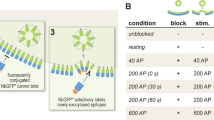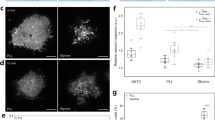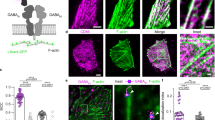Abstract
Image intensified fluorescence microscopy has been very useful in visualising the patterns and mobility of receptors for epidermal growth factor (EGF), insulin and α2-macroglobulin in intact cells1,2. Recently, we have synthesised a bioactive derivative of enkephalin3, Tyr-D-Ala-Gly-Phe-Leu-Lys-rhodamine, and used it for the microscopic visualisation and localisation of opiate (enkephalin) receptors in neuroblastoma cells4. In contrast to the case of polypeptide hormones1,2, where fluorescently labelled receptors are initially distributed uniformly and quickly form patches which are subsequently internalised1,2, the enkephalin-labelled receptor patches in neuroblastoma cells appear only slowly and are not internalised4. Sulphydryl groups are involved in the binding of opiates to brain membranes and may affect differentially the binding of agonists and antagonists5,6. Also, sulphydryl and disulphide groups are involved in the binding sites of adrenergic, cholinergic and muscarinic receptors7–11. These observations prompted us to examine the effects of disulphide and sulphydryl reagents on the clustering of opiate (enkephalin) receptors in N4TG1 neuroblastoma cells. We report here that in these cells there are reactive sulphydryl and disulphide groups which are essential for cluster formation (but not binding), and that a sulphydryl–disulphide exchange reaction may be involved in this process. In addition, the sulphydryl reagents seem to dissociate the two steps of binding and cluster formation, and thus provide a tool for studying the pharmacological importance of receptor clustering.
This is a preview of subscription content, access via your institution
Access options
Subscribe to this journal
Receive 51 print issues and online access
$199.00 per year
only $3.90 per issue
Buy this article
- Purchase on Springer Link
- Instant access to full article PDF
Prices may be subject to local taxes which are calculated during checkout
Similar content being viewed by others
References
Schlessinger, J., Shechter, Y., Willingham, M. C. & Pastan, I. Proc. natn. Acad. sci. U.S.A. 75, 2659–2663 (1978).
Maxfield, F. R., Schlessinger, J., Shechter, Y., Pastan, I. & Willingham, M. C. Cell 14, 805–810 (1978).
Hazum, E., Chang, K-J., Shechter, Y., Wilkinson, S. & Cuatrecasas, P. Biochem. biophys. Res. Commun. 88, 841–846 (1979).
Hazum, E., Chang, K-J. & Cuatrecasas, P. Science (in the press).
Wilson, H. A., Pasternak, G. W. & Snyder, S. H. Nature 253, 448–450 (1975).
Simon, E. J. & Hiller, J. M. A. Rev. Pharmac. Toxicol. 18, 371–394 (1978).
Karlin, A. & Bartels, E. Biochim. biophys. Acta 126, 525–535 (1966).
Moore, H. P. H. & Raftery, M. A. Biochemistry 18, 1907–1911 (1979).
Steinacker, A. Nature 278, 358–360 (1979).
Hedlund, B. & Burtfal, T. Molec. Pharmac. 15, 531–544 (1979).
Vanquelin, G., Bottari, S., Kanarek, L. & Strosberg, A. D. J. biol. Chem. 254, 4462–4469 (1979).
Maxfield, F. R., Willingham, M. C., Davies, P. J. A. & Pastan, I. Nature 277, 661–663 (1979).
Haigler, H., Ash, J. F., Singer, S. J. & Cohen, S. Proc. natn. Acad. sci. U.S.A. 75, 3317–3321 (1978).
Chang, K-J., Miller, R. J. & Cuatrecasas, P. Molec. Pharmac. 14, 961–970 (1978).
Miller, R. J., Chang, K-J., Cooper, B. & Cuatrecasas, P. J. biol. Chem. 253, 531–538 (1978).
Chang, K-J. & Cuatrecasas, P. J. biol. Chem. 254, 2610–2618 (1979).
Author information
Authors and Affiliations
Rights and permissions
About this article
Cite this article
Hazum, E., Chang, KJ. & Cuatrecasas, P. Role of disulphide and sulphydryl groups in clustering of enkephalin receptors in neuroblastoma cells. Nature 282, 626–628 (1979). https://doi.org/10.1038/282626a0
Received:
Accepted:
Issue Date:
DOI: https://doi.org/10.1038/282626a0
This article is cited by
-
Human α2macroglobulin
Molecular and Cellular Biochemistry (1984)
-
Changes in the redox state of neuroblastoma cells after manganese exposure
Archives of Toxicology (1983)
Comments
By submitting a comment you agree to abide by our Terms and Community Guidelines. If you find something abusive or that does not comply with our terms or guidelines please flag it as inappropriate.



